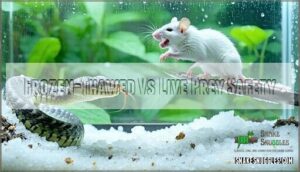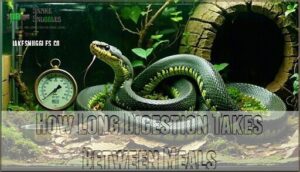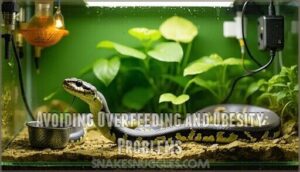This site is supported by our readers. We may earn a commission, at no cost to you, if you purchase through links.

Match prey size to your boa’s girth, not length, since a meal that’s too large risks regurgitation and a too-small one won’t meet nutritional demands. Getting the rhythm right means reading your snake’s body condition and adjusting portions as it grows, because what keeps a juvenile healthy can lead an adult straight into obesity territory.
Seasonal shifts can dampen appetite, especially during breeding cycles or winter months, and stress—from shedding to improper handling—often triggers feeding refusals.
Table Of Contents
- Key Takeaways
- How Often Should You Feed a Boa Constrictor?
- Choosing The Right Prey Size and Type
- Recognizing Proper Digestion and Feeding Response
- Avoiding Overfeeding and Obesity Problems
- Troubleshooting Common Feeding Issues
- Frequently Asked Questions (FAQs)
- How often should I Feed my boa constrictor?
- Do boa constrictors eat too much?
- Can a boa constrictor eat a rabbit?
- How often should you feed a boa constrictor?
- How long can a boa constrictor go without eating?
- How much do you feed a boa constrictor?
- Can you overfeed a boa?
- How to safely thaw frozen prey?
- What to do if a boa refuses food?
- Conclusion
Key Takeaways
- Young boas need meals every 10-12 days, while adults can go 10-14 days between feedings, with temperature directly affecting digestion speed and scheduling. – Prey size should match your boa’s thickest body section rather than its length, and frozen-thawed options are significantly safer than live prey, which injures about 15% of boas. – Overfeeding leads to obesity and shortened lifespans, so monitor body condition carefully and consider erratic feeding schedules that mimic natural hunting patterns. – Skip feeding during shedding cycles, illness, or stress, and if your boa regurgitates, wait 10-14 days before offering a smaller meal to allow digestive recovery.
How Often Should You Feed a Boa Constrictor?
Your boa’s feeding schedule changes as it grows, with babies eating every 10-12 days and adults stretching to every 10-14 days.
Getting the timing right prevents both underfeeding during growth spurts and overfeeding that leads to obesity.
Feeding Schedule for Baby and Juvenile Boas
Your baby boa’s first year is a critical growth window—and getting the feeding schedule right can mean the difference between a thriving snake and one that struggles with health issues down the road. Here’s what you need to know:
- Hatchling feeding (0-6 months): Offer appropriately sized prey items every 10-12 days
- Juvenile frequency (6-12 months): Keep to the same 10-12 day schedule to foster growth spurts
- Prey progression: Start with fuzzy mice, gradually increasing size as your boa grows
- Supplementation needs: Provide calcium and vitamin D3 periodically for proper development
Follow this boa constrictor feeding chart consistently for prime snake feeding and care.
Adult Boa Constrictor Feeding Frequency
Once your boa reaches adulthood—usually around 18 to 24 months—its metabolism slows down considerably, and you’ll need to adjust your feeding schedule to match this natural shift.
Adult boas generally do well on a feeding frequency of once every 10 to 14 days, which aligns with their slower metabolic rate and helps prevent obesity while maintaining proper body condition and healthy digestion.
Factors That Affect Feeding Schedules
A bunch of things affect how often your boa needs to eat. Since they’re cold-blooded, boas depend on the temperature around them to fuel their metabolism and digestion—warmer spots help them digest faster, while cooler areas slow everything down.
Here’s what matters most:
- Temperature Impact: Boas digest meals faster at 30°C than at 25°C, affecting how soon they’re ready for the next feeding
- Prey Size: Larger meals (20-40% body mass) extend digestive duration compared to smaller portions
- Stress Levels: Handling, enclosure changes, or poor environment can trigger feeding refusals and regurgitation
- Age Factors: Juveniles need frequent meals for rapid growth; adults tolerate longer intervals as growth slows
Monitor your boa’s body condition and adjust your boa constrictor feeding chart accordingly. Frozen-thawed prey is considered the most hygienic option for captive boas.
Seasonal eaters may naturally reduce appetite during cooler months when metabolic demands drop.
Seasonal Adjustments and Breeding Cycles
Boa constrictors naturally sync their eating habits with the seasons. Adults typically fast through winter months, going from meals every two weeks in summer to waiting two or three months between feeds when it’s cooler—just like they would in the wild.
Breeding fasting for females usually spans six to eight weeks before pairing, while gestation feeding resumes biweekly after ovulation until birth. Temperature impact drives these seasonal feeding adjustments, so following reptile feeding schedules and a boa constrictor feeding chart helps you match intervals to your snake’s needs as a seasonal eater. They’re also found in Central and South America.
Choosing The Right Prey Size and Type
Getting the prey size right isn’t just about convenience—it directly impacts your boa’s health, digestion, and long-term growth.
You’ll need to match prey diameter to your snake’s girth and choose appropriate species based on age, while understanding the safety trade-offs between live and frozen-thawed options.
Measuring Prey Against Your Boa’s Girth
When sizing prey for your boa, forget complicated measurements. Just match the food to your snake’s thickest section—usually somewhere around the middle.
Here’s the simple approach using safe prey handling and visual size assessment:
- Find your boa’s widest spot along the body
- Pick prey that’s about the same size or slightly smaller than that width
- Watch for the right bulge—you want it visible but not dramatic
Stick to these boa constrictor feeding guidelines and you’ll nail the prey size ratios without worrying about impaction.
Best Prey Options for Different Life Stages
Your boa’s nutritional needs shift dramatically as it grows, so matching prey type to life stage matters. Hatchling boas thrive on pinkie mice (1–3 grams) or pinkie rats (4–9 grams) every 5–7 days—these small rodents are easy to digest and fuel rapid growth.
Juveniles move to hopper mice or weaned rats (33–49 grams), with occasional chicks for variety. Adults handle large rats (275–374 grams) or whole rabbits, and alternating between rodents and birds promotes long-term vitality.
A boa constrictor feeding chart helps you track prey weight as your snake matures, making frozen-thawed options meet changing nutritional demands.
Frozen-Thawed Vs Live Prey Safety
When you’re picking between frozen-thawed and live prey for your boa, safety should be your main concern. Live rodents bite and scratch about 15% of boas during feeding, which can lead to serious injuries. Frozen-thawed prey completely eliminates this risk.
There’s another bonus—freezing kills most parasites that could make your snake sick. Studies show infection rates drop from 14% with live prey down to just 2% with frozen options. As long as you use frozen prey within three months, the nutritional value stays solid, though adding occasional vitamin supplements doesn’t hurt.
Handling gets easier too. No worrying about getting bitten by a live rodent, and proper thawing keeps bacteria from growing. When you’re setting up your feeding schedule, frozen-thawed should be your go-to choice for keeping your boa safe and healthy.
Handling safety improves too—no live bites, and proper thawing prevents bacterial growth. Your snake feeding chart should default to frozen-thawed for injury prevention and overall boa constrictor care.
When to Increase Prey Size
Once you’ve nailed down the safest feeding method, your next question is probably: when does my growing boa actually need a bigger meal?
Watch your snake’s body condition and growth rate closely. If the prey item leaves no visible lump after digestion, or your boa is putting on length without much girth, it’s time to size up.
Most keepers consult a boa constrictor feeding chart and adjust prey weight gradually—never jump two sizes at once, as that can overwhelm digestive capacity and trigger regurgitation.
Recognizing Proper Digestion and Feeding Response
Knowing when your boa is ready for its next meal prevents overfeeding and digestive stress. Watch for visual cues like body shape returning to normal and consistent activity levels—these signs tell you digestion is complete and your snake’s ready to eat again.
How Long Digestion Takes Between Meals
Boa constrictors need time to fully digest their meals. Think of it like a really slow cooking process—breaking down everything from fur to bones takes days, not hours. Feed too soon and you’re asking for trouble.
Several things affect how long this takes:
- Temperature matters—cooler tanks slow everything down
- Don’t feed during sheds—their bodies are focused elsewhere
- Keep them hydrated—it helps their enzymes work properly
- More active snakes digest faster
- Bigger meals take longer—makes sense, right?
Most boas finish processing food in 5-10 days when kept at the right temperature.
Most boas digest meals within 5-10 days at proper temperatures.
Signs Your Boa is Ready to Eat Again
Knowing when your boa is genuinely hungry—not just opportunistic—can mean the difference between a healthy snake and an overweight one struggling with metabolic issues.
Watch for increased tongue flicking, heightened activity levels, and deliberate enclosure exploration—these indicate your boa constrictor is ready for another meal.
However, if your snake’s still hiding or mid-shedding cycle, hold off on feeding to prevent regurgitation and foster proper snake health and nutrition.
What a Healthy Post-Meal Lump Looks Like
After your boa eats, you’ll notice a visible bulge along its body—and understanding what’s normal versus concerning can save you a lot of worry. A healthy post-meal lump should be smooth and distinct but not overly distended.
Following proper snake feeding guidelines, the prey item shape should create a bulge roughly equal to your boa constrictor’s thickest body section.
Gently palpating the lump helps assess digestive health signs—it should feel firm but not rock-hard, which could indicate impaction requiring veterinary attention.
When to Skip a Feeding
Even when everything looks perfect, there are times when skipping a meal is the smartest move you can make for your boa’s health. Recognizing these situations prevents overfeeding and keeps your snake safe.
Hold off on feeding when you notice:
- Illness indicators like lethargy, mouth gaping, or unusual discharge
- Shedding cycle beginning—cloudy eyes mean digestion difficulties ahead
- Brumation period approaching, when metabolism naturally slows
- Stress factors present, including recent relocation or handling
If your boa just ate, wait the full interval between feedings before offering another meal.
Avoiding Overfeeding and Obesity Problems
Overfeeding your boa can lead to obesity, shortened lifespan, and serious health complications that are easier to prevent than reverse.
Learning to assess body condition and adjust feeding frequency helps you maintain a lean, healthy snake throughout its life.
Your boa’s body should look balanced—not plump like a sausage, but not bony and triangular either. Think of it as the sweet spot between too fat and too thin.
A healthy boa constrictor should have a body shape that’s neither round like a sausage nor sharp and angular like a triangle—it’s all about finding that Goldilocks middle ground.
You’ll want to use visual assessment and palpation techniques to check your boa’s body condition score. Run your fingers along the spine—you shouldn’t feel sharp vertebrae poking out, but the backbone shouldn’t disappear under fat rolls either.
Monitor weight regularly and watch hydration status, as proper snake health depends on balanced animal weight management.
Dangers of Power Feeding Young Snakes
Power feeding young boa constrictors—pushing rapid growth through frequent, oversized meals—damages snake health in ways that compound over time. Reduced lifespan is well-documented: power-fed boas may live only 15–20 years instead of 30.
Power feeding young boas slashes their lifespan from 30 years to just 15-20 through rapid, forced growth that damages organs permanently
Organ dysfunction follows, with fatty liver disease risk tripling and cardiac changes appearing in 31% of cases. Metabolic disturbances like bone disease affect up to 40% of juveniles.
Digestive overload doubles regurgitation rates, while behavioral consequences include 60% less activity and physical deformities in one in five snakes.
Adjusting Meal Frequency for Weight Management
If you’ve noticed your boa packing on extra weight despite following a standard schedule, it’s time to dial back the frequency rather than just reducing prey size. Spacing feedings further apart—say, every 14 to 21 days for adults—allows your boa constrictor’s metabolic rate to stabilize while preventing excess fat deposits.
Monitor body condition closely, and remember that proper hydration and digestion aid healthy weight management alongside adjusted reptile feeding schedules.
Using Erratic Feeding to Prevent Obesity
One strategy that works surprisingly well—though it sounds counterintuitive at first—is feeding your boa on a less predictable schedule instead of rigidly sticking to the same day every week. This approach mimics natural hunting patterns, where meals aren’t guaranteed on a set calendar, and helps prevent your snake from expecting food constantly.
Benefits of erratic feeding schedules include:
- Reduced metabolic rate between meals, preventing excessive fat storage
- Stronger feeding response when prey is offered, since your boa can’t anticipate it
- More natural activity levels that mirror wild behavior patterns
- Better hunger cues that help you gauge when feeding is truly needed
- Enhanced prey diversity opportunities without disrupting rigid routines
You might feed every 10 days one cycle, then 14 days the next—always monitoring body condition and adjusting based on what you observe rather than what the calendar dictates.
Troubleshooting Common Feeding Issues
Even with a solid feeding schedule, things don’t always go as planned. Regurgitation, feeding refusals, and stress-related health issues can catch you off guard if you’re not prepared.
Understanding why these problems happen—and how to address them safely—keeps your boa healthy and your feeding routine on track.
When your boa regurgitates, it’s sending a clear message that something’s off. The next couple days matter—handle this right and your snake bounces back, mess it up and things can get serious fast.
Don’t freak out though. Common culprits include handling too soon after a meal, wonky temperatures, or giving prey that’s just too big.
Regurgitation isn’t just messy—it’s your boa’s way of telling you something went wrong, and how you respond in the next 48 hours can make the difference between a quick recovery and a dangerous downward spiral. First, don’t panic—causes of regurgitation include handling too soon after feeding, incorrect temperatures, or prey that’s too large.
Your immediate action? Leave your snake completely alone for 10-14 days. No handling, no feeding. This rest period lets the digestive tract heal. For future feedings, offer prey half the normal size and wait an extra week between meals.
If regurgitation happens twice, you’ll need veterinary care—repeated episodes signal potential bacterial infections or regurgitation syndrome, which can be fatal in young boas without proper reptile care and animal nutrition adjustments.
Handling Feeding Refusals and Strikes
When your boa turns its nose up at dinner or strikes defensively during feeding time, it’s not being stubborn—it’s telling you something important about its environment, health, or stress levels. Common refusal causes include incorrect temperatures, shedding cycles, or breeding season.
Check your husbandry first—temperature, humidity, and hiding spots matter. For strike prevention during snake feeding guidelines, use tongs to present frozen-thawed prey items, never your hands.
If your boa repeatedly refuses meals beyond three weeks, seek veterinary help to rule out illness.
Preventing Respiratory and Digestive Infections
Keeping your boa healthy starts with control over humidity and temperature. Respiratory infections jump 70% when humidity tops 80% or temps fall too low.
Good ventilation cuts respiratory problems dramatically, while weekly substrate changes slash bacterial counts by over 80%.
Always feed frozen-thawed prey; it reduces injuries by 88% and lowers infection risk.
Watch for subtle signs like reduced appetite or lethargy—routine fecal screening catches asymptomatic digestive infections in nearly a third of captive boas before symptoms escalate.
Safe Feeding Practices to Reduce Stress
Stress during feeding doesn’t just make your boa reluctant to eat—it can trigger regurgitation, suppress immune function, and turn mealtime into a dreaded ordeal for both of you.
To minimize stress, use proper handling techniques—avoid contact 24-48 hours before offering frozen-thawed prey items. Present prey in a dimly lit feeding enclosure with minimal visual disturbances.
Reduce interaction during digestion, as movement or lighting changes can disrupt your boa constrictor’s feeding and nutrition cycle entirely.
Frequently Asked Questions (FAQs)
How often should I Feed my boa constrictor?
Your boa’s feeding schedule depends on age and metabolism rates. Juveniles need prey items every 5-7 days, while adults eat frozen-thawed meals every 10-14 days.
Seasonal feeding adjustments affect reptile nutrition timing.
Getting your boa’s feeding routine right takes a few key steps. Start by making sure those frozen-thawed prey items are completely warmed through in warm water.
When it’s time to feed, grab your feeding tongs and present the prey head-first. This mimics how they’d hunt in the wild and keeps you safely away from their strike zone.
Proper feeding technique involves several critical steps. First, make certain your frozen-thawed prey items are completely thawed using warm water.
Use feeding tongs to present the prey head-first, mimicking natural hunting behavior while maintaining a safe distance from your boa’s strike zone.
Do boa constrictors eat too much?
Absolutely, boa constrictors can overeat if you let them. Unlike mammals, snakes lack natural satiety cues and will consume prey items whenever offered.
Power feeding dangers include rapid weight gain, shortened lifespans, and digestive stress.
Erratic feeding schedules help prevent obesity while maintaining healthy snake nutrition through proper prey variety and supplementation needs.
Can a boa constrictor eat a rabbit?
Yes, boa constrictors can eat rabbits, though rabbits are usually reserved for larger adult specimens. Here are key considerations for rabbit feeding:
- Rabbit Size Matters – Choose young rabbits appropriately sized to your boa’s girth, never exceeding the thickest body section
- Rabbit Nutritional Value – Rabbits offer excellent protein and fat content, providing dietary variety beyond standard rodents
- Wild Rabbit Risks – Always use captive-bred, frozen-thawed rabbits to avoid parasites and diseases from wild specimens
- Rabbit Introduction Methods – Introduce rabbits gradually after your boa consistently accepts large rats as prey items
- Rabbit Alternative Prey – Use rabbits occasionally for enrichment while maintaining rodents as the primary feeding staple
How often should you feed a boa constrictor?
Most snake keepers discover that feeding frequency isn’t one-size-fits-all—your boa’s age determines everything.
Young boas need meals every 10-12 days, while adults eat every 10-14 days, with seasonal changes affecting appetite during breeding cycles.
How long can a boa constrictor go without eating?
Healthy adult Boa Constrictors can survive several months without food, though individual differences affect this timeline considerably. Their slow metabolism naturally facilitates extended fasting periods, but stress factors and health impacts require careful monitoring.
- Fasting periods vary by age – juveniles need food more frequently than adults due to growth demands
- Brumation effects during cooler months can naturally extend time between meals without health concerns
- Stress factors like illness, shedding, or environmental changes may cause temporary feeding refusals
How much do you feed a boa constrictor?
Think giant snake, tiny brain for portion control—your boa can’t count calories like you do. The prey weight ratio should equal 10-15% of your boa’s body weight, creating a visible but manageable meal size impact on their body condition.
| Boa Weight | Prey Size |
|---|---|
| 500g juvenile | 50-75g rodent |
| 2kg adult | 200-300g rodent |
| 4kg large adult | 400-600g rodent |
| 6kg+ breeding female | 600-900g rodent |
Frozen-thawed rodents work best for Boa Constrictors since they’re safer than live prey and provide consistent reptile nutrition. You’ll know you’ve nailed the meal size when there’s a slight lump visible after feeding—too big creates digestive stress, too small won’t satisfy their nutritional needs.
Supplementation needs stay minimal with whole prey, but hydration importance can’t be overstated. Keep fresh water available constantly, especially after feeding when their metabolism kicks into high gear processing that substantial meal.
Can you overfeed a boa?
You can definitely pile on too many meals, turning your boa into a chunky noodle with serious health problems. Obesity risks from power feeding include shorter lifespans, while erratic feeding patterns actually help maintain proper dietary balance and prevent overfeeding issues in boa constrictors.
How to safely thaw frozen prey?
When thawing frozen prey for your boa, use lukewarm water or refrigerator defrosting to prevent bacterial growth and preserve nutritional value while assuring safe handling practices.
- Room temperature thawing: Never leave rodents on counters – bacteria multiply rapidly at room temperature, creating health risks for your snake
- Warm water method: Submerge sealed prey in lukewarm (not hot) water for 30-60 minutes, changing water halfway through the process
- Refrigerator thawing: Safest option requiring 8-12 hours, preserving nutrients and minimizing bacterial risks through controlled temperature
- Temperature verification: Make certain prey feels slightly warm to touch before feeding – cold meals can cause regurgitation in boa constrictors
- Immediate feeding: Use thawed rodents within 24 hours and never refreeze, as repeated freeze-thaw cycles compromise nutritional quality
What to do if a boa refuses food?
Sometimes your boa will unexpectedly turn its nose up at dinner, leaving you wondering what went wrong.
Check Environmental Factors like temperature and humidity first. Then, consider if your snake is entering its Shedding Cycle or experiencing Handling Stress, which naturally suppresses appetite in healthy boas.
Conclusion
Picture a snake that’s skin-and-bones beside one that’s practically bursting at the seams—your boa constrictor feeding schedule makes all the difference between these extremes. Getting the timing right isn’t rocket science, but it does require paying attention to your snake’s age, body condition, and environmental factors.
Young boas need frequent meals to fuel their rapid growth, while adults thrive on less frequent but appropriately sized prey. Monitor your boa’s response, adjust for seasonal changes, and you’ll maintain a healthy, well-fed snake for years to come.
- https://talis-us.com/blogs/news/boa-snake-food-a-guide-to-feeding-your-boa-constrictor
- https://www.petmd.com/reptile/boa-constrictor-care-sheet
- https://www.reddit.com/r/snakes/comments/4d3gog/bcc_owners_how_often_and_how_large_do_you_feed/
- https://www.animalsathome.ca/boa-constrictor-feeding-chart/
- https://darrenhamillreptiles.com/boa-constrictor-husbandry/
















